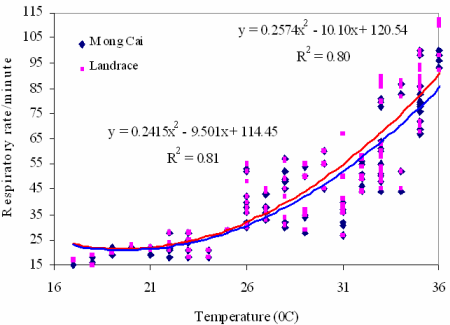Effect of the environmental factors on physiological
parametters, feed intake and growth of Mong cai and Landrace pigs
in central Vietnam
Le Van Phuoc and Le Duc Ngoan
Hue University of Agriculture and Forestry
Abstract
An experiment was conducted on 12 Mong Cai pigs (initial weight 16 kg) and 12 Landrace pigs (initial weight 24 kg), kept individually in pens (1.5 m2/head). Every pig of each breed was fed with two diets with equal crude protein content (16% for Landrace and 13% for Mong Cai) and equal ME (3000 Kcal/kg feed), but different crude fibre levels: 6% and 9% (using sweet potato leaves and stem to adjust the fibre rate). Feed and water were free choice. The experiment lasted 90 days. Temperature and humidity were measured by magnetic humidity - thermometers hanging 1.5 m from the floor of the pen, records being taken of the mean of 3 measurements (at 6.00, 12.00 and 18.00). The physiological indices such as respiratory rate, heart beat and body temperature were measured randomly at different temperature and moisture points. The weights of the pigs were measured every month.
There was a significant correlation between air temperature change and some physiological indices such as: respiratory rate, heart beat and body temperature. The Landrace breed was more sensitive to the change of environmental factors than the Mong Cai breed. Air temperature significantly affected feed intake of the pigs. With 6% and 9% fibre level in the diets, there was no difference in growth and feed consumption.
Key words: Pigs, environment, temperature, humidity, fibre, growth
Introduction
Biological yield of domestic animals in general, especially of
pigs, is often affected by the factors of climate and nutrition. In Central
Vietnam due to difficulties of climate,
and poor knowledge of farmers, the yield of pig production is still
considerably low. In the past few years, due to the increasing demand for
lean meat for the
domestic market and for exportation, the farmers have
tendency to keep exotic and cross-breed pigs. Thus, research on
environmental factors such as temperature and humidity, and nutritional
factors such as fibre
in the ration, is necessary in order to find out the suitable pig production
model, as well as suitable use of local available feed to enhance
economic effectiveness of pig production.
Materials and method
The experiment was conducted on 12 Mong Cai pigs (initial weight 16 kg) and 12 Landrace pigs (initial weight 24 kg), kept individually in pens (1.5 m2/head). Every pig of each breed was fed two diets with equal crude protein (16% for Landrace and 13% for Mong Cai) and equal ME (3000 Kcal/kg feed), but different fibre levels: 6% and 9% (using sweet potato leaves and stem to adjust the fibre level). Feed and water were offered ad libitum. The experiment lasted 90 days.
Temperature and moisture were measured by magnetic humidity - thermometers hanging 1.5 m from the floor of the pen and the mean of 3 measurements was taken (at 6.00, 12.00 and 18.00 h). Physiological indices such as respiratory rate, heart beat and body temperature were measured randomly at different temperature and humidity levels. The weights of the pigs were measured every month. Records were kept of feed intake.
Data were analysed by ANOVA using the software of Minitab version 13.
Results and discussion
Effect of air temperature on respiratory rate of pigs
Among reactions of the body to temperature change, change of respiratory rate has the most important role, especially in pigs (Figure 1).
|
|
|
|
When the temperature increased from 17oC to 34oC, the respiratory rate of both pig breeds was enhanced, increasing at a faster rate as the temperature rose above 25oC (Figure 1). In this experiment when air temperature was above 25oC the respiratory rate of Landrace breed was higher than for the Mong Cai breed. Ranges of respiratory rate of Landrace and Mong Cai pigs were 17-110 times/minute and 17-101 times/minute, respectively. This confirms that the Mong Cai breed is better adapted to the hot climate. The relation between air temperature and respiratory rate of pigs was described by following regression:
Effect of air temperature on heart beat rate of
pigs
Besides the change of respiratory rate when air temperature increased, the heart beat of pigs increased as well. However, increasing of the heart beat is lower in comparision with the respiratory rate. Figure 2 discribes the relation between air temperature and heart beat of 2 pig breeds.
|
|
|
|
The variation of the heart beat was similar to that for respiratory rate, with the rate increasing more rapidly above 25oC. When air temperature increased from 17oC to 36oC heart beat of Landrace and Mong Cai pigs increased from 91 to 132 beat/minute and from 86 to 122 beat/minute, respectively. Thus, at the same point of air temperature, the heart beat of Landrace pigs was higher than of Mong Cai.
Effect of air temperature on body temperature (rectal
temperature) of pigs
When air temperature changed, body temperature of both pig breeds was changed. When air temperature increased from 17oC to 36oC, body temperature of both Landrace and Mong Cai pigs was enhanced from 38.3oC to 39.7oC. However, within the range of air temperature during the time of the experiment, body temperature of both pig breeds was still within normal physiological limits.
Effect of air temperature on feed intake of pigs
When air temperature increased or decreased 1oC, feed intake of Landrace and Mong Cai pigs was increased or decreased 10% and 7%, respectively (Figure 3)..

Figure 3. Effect of air temperature on feed
intake of pigs
Effect of fibre level in the diet
Growth rates and feed conversion did not differ between diets but the diet with the high fibre content resulted in a low dry matter content in the manure and vice versa (Table 1). This could be explained by the high fibre content increasing the peristaltic action of the intestine, decreasing water absorbability and shortening the time of feed staying in the alimentary tract.
|
Table 1: Effect of crude fibre level in the diet on growth rate and feed conversion and content of dry matter in pig manure |
||||
|
|
Landrace |
Mong Cai |
||
|
Fibre content (% in DM) |
6 |
9 |
6 |
9 |
|
Initial weight (kg) |
24 |
23.5 |
16 |
15.5 |
|
Final weight (kg) |
81.5 |
78.9 |
49.2 |
47.5 |
|
Weight gain (g/day) |
639 |
616 |
368 |
355 |
|
Feed conversion # |
3.23 |
3.42 |
3.51 |
3.49 |
|
DM of manure (%) |
34.6 |
28.6 |
33.1 |
29.9 |
|
# DM feed/weight gain (kg/kg) |
||||
Conclusions
-
There is a significant correlation between air temperature change and some physiological indices of pigs such as: respiratory rate, heart beat and body temperature. The Landrace breed is more sensitive to the change of environmental factors than the Mong Cai breed.
-
Increase in air temperature reduced feed intake
-
Diets with higher content of fibre produced manure of lower dry matter content

